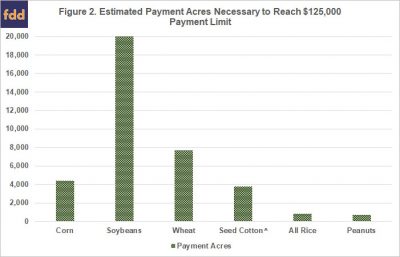House Republicans are planning to revive farm bill negotiations in January after failing to garner enough political will to pass a new deal by the end of the year, as…
House Narrowly Passes Farm Bill
Wall Street Journal writers Jesse Newman, Heather Haddon and Siobhan Hughes reported on Thursday that, “The House on Thursday narrowly passed a Republican-written bill that reauthorizes farm programs while also imposing controversial new work requirements on food-stamp recipients, acting on legislation that is important to a critical GOP constituency before the midterm elections.
“The bill passed on a 213-211 vote. The Senate is expected to vote next week on its own version of the bill, which funds crop insurance and payments to farmers when commodity prices or revenues drop below set levels. The measure also funds programs to help low-income people afford basic nutritional needs.”
Seen on C-SPAN: U.S. House approves #FarmBill, 213-211. https://t.co/3mNciKfdIg pic.twitter.com/494n4qlQch
— CSPAN (@cspan) June 21, 2018
“The bill’s work requirements reflect a drive by House Republicans to overhaul the country’s welfare system. On Thursday, House Speaker Paul Ryan (R., Wis.) touted the provision as a way to ‘close the skills gap and get more people into the workforce and onto the ladder of opportunity.’
It is likely to get stripped out in the Senate, where members have statewide constituencies and are more likely to represent populations who depend on the supplemental nutritional program.
The Journal writers added that, “Congress typically waits until the last minute to pass the legislation, but Senate Majority Leader Mitch McConnell (R., Ky.) said earlier this year that Republicans ‘are obviously stronger in rural and small town American than we are in the big cities and the coast, so for us not to produce a farm bill would be a negative.’
“The bill’s passage is important to the Farm Belt, which is gripped by anxiety over escalating trade tensions between the U.S. and key foreign buyers of American agricultural products. In response to U.S. tariffs on imports of Chinese steel and aluminum, Beijing in April imposed duties on a range of U.S. goods including pork and fruit. That sparked alarm among farmers already navigating the steepest downturn in the agricultural economy in decades, as well as uncertainty over the North American Free Trade Agreement, which has been a boon to many U.S. farmers.”

DTN Ag Policy Editor Chris Clayton reported on Thursday that, “The farm bill got its votes, all Republican, after House leadership agreed to hold votes on immigration bills championed by conservatives. The initial immigration bill that GOP members wanted still failed earlier in the day.”
Mr. Clayton explained that, “The House farm bill makes few changes to the commodity programs farmer rely on. It does change the Agricultural Risk Coverage (ARC) to use crop-insurance data to calculate yields. The House bill also eliminates the individual farm coverage under ARC and sticks solely with the county program. The bill maintains the same reference prices for nearly every commodity in the Price Loss Coverage (PLC) program.
“The House bill would eliminate new signups under USDA’s largest conservation program, Conservation Stewardship Program (CSP). The contracts for the current 72 million acres in CSP would continue until they expire, but no new enrollment would be allowed. Instead, the bill would investment more in the Environmental Quality Incentives Program (EQIP).
“The Conservation Reserve Program (CRP) would increase by 5 million acres, to 29 million acres, but would reduce rental rates to 80% of the current average county rental rate for ground.”
The DTN article also pointed out that, “Neither the House nor Senate farm bill includes language tied to the White House reorganization plan that would move the SNAP program from USDA over to the Department of Health and Human Services. USDA’s Rural Housing Service would move to the Department of Housing and Urban Development.”
.@MickMulvaneyOMB talking about reforming the fed government (w/ @EPAScottPruitt in background) on @BloombergTV -Proposed reforms: Take #SNAP (food stamp) administration from @USDA and move it to @HHSGov, move @usdaRD housing programs to @HUDgov -goo.gl/gm9jEJ pic.twitter.com/CmcWyzdx54
— Farm Policy (@FarmPolicy) June 21, 2018
Reuters writer Amanda Becker reported on Thursday that, “The U.S. House of Representatives on Thursday approved a massive Republican farm bill with changes to the government food stamps program that make it unlikely to become law in this form.
“The Senate is considering its own farm bill with no major changes to the Supplemental Nutrition Assistance Program (SNAP) used by more than 40 million Americans, or about 12 percent of the total U.S. population.”
Ms. Becker added that, “The Republican SNAP proposals in the current farm bill would expand the number of non-disabled individuals subject to work requirements by raising the top age to 59 from 49 and including more people caring for school-age children. It would also put new limits on state governors’ ability to waive work requirements in economically depressed areas.”
Farm Bill just passed in the House. So happy to see work requirements included. Big win for the farmers!
— Donald J. Trump (@realDonaldTrump) June 21, 2018
And Bloomberg writer Alan Bjerga reported on Thursday that, “With Democrats holding more power in the almost evenly divided Senate, that chamber’s Agriculture Committee is leaving food stamps largely alone. But inaction on work requirements could also kill the farm bill’s chances of either House passage or approval by President Donald Trump, who has said he wants stringent work requirements. Trump tweeted Thursday that he’s ‘so happy to see work requirements included.'”
Recall that a farmdoc daily update this week pointed out that, “Farm bill progress in the Senate has the potential to create momentum for completing reauthorization but potential hurdles remain. Looking ahead to a potential conference negotiation, there are numerous differences to work out between the House and Senate versions of the farm bill. The most prominent involve the House’s proposals for the Supplemental Nutrition Assistance Program (SNAP) and conservation policy, as well as for farm program design.
Among them, the issue of farm program payment limits and eligibility requirements stands out.

After the House vote, House Agriculture Committee Chairman Mike Conaway (R., Tex.) noted that, “I’m proud of what this body has accomplished, and now look forward to working with the Senate and the president to deliver a farm bill on time to the American people.”
Kudos to @ConawayTX11 & House Ag Committee for full House passage of #FarmBill. Very important to give the agriculture community some much-needed certainty.
— Sec. Sonny Perdue (@SecretarySonny) June 21, 2018
Committee Ranking Member Collin Peterson (D., Minn.) indicated in a statement that, “The only upside to its passage is that we’re one step closer to conference, where it’s my hope that cooler heads can and will prevail. The Senate’s version isn’t perfect, but it avoids the hardline partisan approach that House Republicans have taken here today, and if it passes, I look forward to working with conferees to produce a conference report both parties can support, which is the only way to get a farm bill enacted into law.”
Leader McConnell has filed cloture on the motion to proceed to H.R.2, Farm Bill
— Senate Cloakroom (@SenateCloakroom) June 21, 2018
Also on Thursday, Senate Agriculture Committee Chairman Pat Roberts (R., Kans) stated that, “I congratulate Chairman Conaway on successfully navigating his Farm Bill through the House. I look forward to working with him and his colleagues in conference once the Senate passes our Farm Bill. Our farmers and ranchers need certainty and predictability. They are counting on us.”





